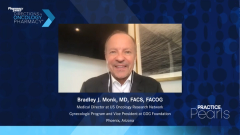
Practice Pearl 2: Using PARP Inhibition For First-Line Maintenance of Ovarian Cancer
Drs Jennifer MacDonald, Bradley J. Monk, and Sarah Hayward review current FDA-approved PARP inhibitors for first-line maintenance therapy for patients with ovarian cancer.
Episodes in this series

Jennifer MacDonald, PharmD, BCOP: This has changed. I feel like SOLO-1 came out and blew things up. Dr Monk, you’d probably agree with that. I remember being at the SGO [Society of Gynecologic Oncology] Winter Meeting, and the big Mack truck got put between the curves. Everyone was super excited about having data. Why do you feel like these data and agents in the frontline maintenance settings are so important for your patients?
Bradley J. Monk, MD, FACS, FACOG: Yes, the first author of SOLO-1 was Katie Moore. Where does she work anyway?
Sarah Hayward, PharmD, BCOP: I’ve seen her around here sometimes.
Bradley J. Monk, MD, FACS, FACOG: She works with Dr Hayward every day. That was a groundbreaking unprecedented result which led to the FDA approval in December of 2018 with a hazard ratio of 0.30 in frontline maintenance, but only in BRCA patients. It was published in The New England Journal of Medicine and approved around the world. It was game-changing, but only in patients with BRCA mutations. We had to learn how to test for somatic because somatic testing increased the opportunity by 50%. Let’s just say if germline were 17%, then you check somatic, you get another 7% to 8% and you get all the way to 25%. But although it was wonderful—we now have 5-year data from ESMO [European Society for Medical Oncology Congress]—it still ignored 75% of the patients with high-grade serous fallopian tube, ovarian, and peritoneal cancer.
Jennifer MacDonald, PharmD, BCOP: Yes, definitely. Everyone was really excited when that came out, and we’ve just added to that. We’ve gotten more data in the frontline setting with some results from PRIMA. Sarah, to paint the picture for everyone who may not be familiar in gynecologic oncology, in the frontline maintenance setting, what’s currently FDA approved for use in patients with ovarian cancer?
Sarah Hayward, PharmD, BCOP: Current FDA approvals for frontline maintenance and the use of PARP inhibitors is just like we just spoke about. And Dr Monk spoke on the SOLO-1 trial. We have olaparib [Lynparza]. This is specific for patients who have a BRCA mutation. Also, the results from the PRIMA trial, which looked at niraparib [Zejula], gave us an approval for PARP inhibition for all-comers, patients who’ve had successful treatment with frontline platinum-based therapy. And then also for frontline setting we have the PAOLA-1 study, which is the combination of olaparib plus bevacizumab [Avastin]. This is for patients who received bevacizumab as part of their frontline platinum-based chemotherapy and who have not specifically BRCA but are HRD [homologous recombination deficiency]-positive. That’s what we have approval for right now.
Jennifer MacDonald, PharmD, BCOP: Perfect. Dr Monk, do you have any comments or caveats that you use? You get a patient, you get them through their chemotherapy, and then you’re reaching maintenance therapy. We touched on this, but rounding out and making sure we hone it in, who might you pick for olaparib vs niraparib vs maybe using a combination with bevacizumab?
Bradley J. Monk, MD, FACS, FACOG: Yes, thank you. I’ve had the opportunity to work on bevacizumab as well, and the question comes down to bevacizumab. Because if you’re not using bevacizumab with chemotherapy, you’re not going to start using it in the maintenance phase.
Jennifer MacDonald, PharmD, BCOP: Correct.
Bradley J. Monk, MD, FACS, FACOG: My data have been misinterpreted, and it’s probably my fault that somehow there are low-risk stage 3 and 4 patients. There’s no such thing. You can die even from a stage 3 R0 high-grade serous ovarian cancer. In my mind, all patients who are stage 3 and 4 deserve the benefit from bevacizumab frontline unless there’s a contraindication, which would include diverticulitis, inflammatory bowel disease, or medical conditions such as unstable thrombosis, unstable hypertension, risk of bleeding, or non-healing wound—the GI [gastrointestinal] perforation risks and medical risks. That’s about 10% of patients. So 90% of patients should probably start with bevacizumab. That’s a very polarizing comment, and I get it.
Jennifer MacDonald, PharmD, BCOP: I will say, we’re not a large bevacizumab center.
Bradley J. Monk, MD, FACS, FACOG: I hope that we can persuade you.
Jennifer MacDonald, PharmD, BCOP: I can debate to some degree.
Bradley J. Monk, MD, FACS, FACOG: Absolutely.
Jennifer MacDonald, PharmD, BCOP: Or I can just put a plug out there that not everybody uses bevacizumab in the frontline setting.
Bradley J. Monk, MD, FACS, FACOG: It’s OK.
Jennifer MacDonald, PharmD, BCOP: It’s definitely something to consider.
Transcript Edited for Clarity
Newsletter
Stay informed on drug updates, treatment guidelines, and pharmacy practice trends—subscribe to Pharmacy Times for weekly clinical insights.

















































































































































































































